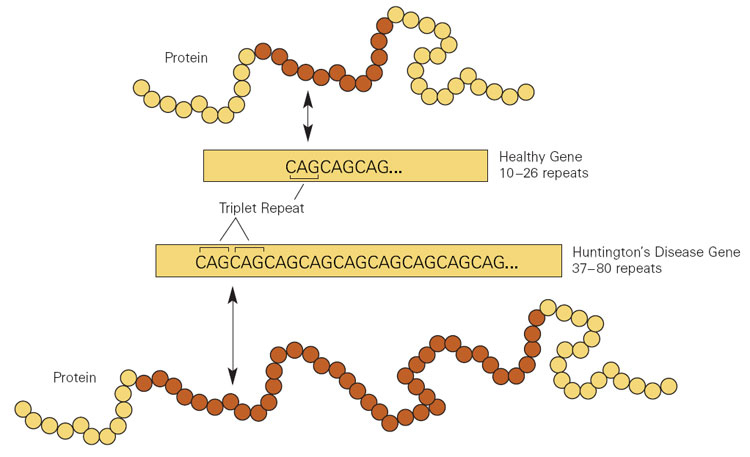Huntington's disease is caused by more than a mutated protein
A new study illuminates the role of small RNA in the disease, laying the foundation for new diagnosis and treatment options
Dr. Steven Finkbeiner, Gladstone Institute of Neurological Disease, The Taube-Koret Center for Huntington's Disease Research, and the University of California San Francisco on Wikimedia Commons (CC BY 3.0)
One of the most critical functions of a cell is to create proteins. For this, the cell need instructions, which are written in the DNA. However, DNA is too precious to put at risk of any damage, and therefore, it never leaves the cell's nucleus. The solution is RNA, a copy of the DNA's instructions that travel from the nucleus to the protein factories.
The process of copying DNA's instructions into RNA can sometimes go wrong, creating instructions that are misleading and end up making a defective or mutated protein. This is the case for Huntington's disease. Huntingtin protein is found in most of the body's tissues, with the highest levels of activity in the brain. Its exact function is unknown but is essential for normal development before birth and it appears to play a fundamental role in neurons. But some mistakes in the instructions responsible for creating the huntingtin protein cause the protein to lengthen like a tape measure, becoming toxic for the nerves in the brain. The defective huntingtin protein forms clumps in brain cells, damaging and eventually killing them.
Researchers investigating Huntington's disease have been focusing most of their attention to study the wrongly copied RNA and its resultant mutated protein. However, this protein alone isn't enough to explain all the effects of the disease.
The idea that the mutated huntingtin protein has some accomplices has gained interest in recent years. While the origin of the disease has been associated with the abnormal functioning of the mutated protein, a few studies have showed the involvement of other molecular mechanisms.
That is the case of a recent study published in Acta Neuropathologica, in which researchers from the University of Barcelona describe new accomplices known as small RNAs. As their name indicates, small RNAs are shorter forms of RNA which are not used to build proteins, but instead help with other functions, like turning on or off other genes.
To know if those small RNAs could act independently from the mutated huntingtin protein, the researchers isolated them from the brains of deceased people with Huntington's disease who had donated their tissues to science, then injected them into the brains of healthy mice. The mice promptly developed symptoms similar to human Huntington's, showing that these small RNAs were enough, all on their own, to create disease.
The scientists also wanted to know if all of the small RNAs came from wrongly copied huntingtin RNA or if some of them were coming from other sources. To find this out, they specifically blocked small RNAs with the same sequence as the wrongly copied RNA, thus inhibiting their function. The blockage alleviated the symptoms, but only to a limited extent. This indicated that there were some small RNAs, acting independently from both the mutated huntingtin RNA and protein, that contributed to the disease seen in the mice.

Figure showing the healthy huntingtin protein (top) and the mutated version (bottom)
National Institute of General Medical Sciences, National Institutes of Health on Wikimedia Commons
This finding holds great promise for diagnosing the Huntington's before the symptoms appear. Currently, a DNA test can determine if a person has the faulty gene that causes Huntington's disease. This is called predictive testing. When the gene is mutated, it contains an expanded segment, which contains several repetitions of the same DNA sequence.
Doctors interpret the results of the test based on the number of repetitions they see in the DNA that codes for the huntingtin protein. If there are only a small number of repetitions, 26 or fewer, disease can be ruled out. On the other hand, a higher number of repetitions, 40 or above, is always associated with the development of the disease at some point in the future. In the intermediate range, between 27 and 39 repetitions, whether or when, if at all, a person will develop Huntington's disease symptoms cannot be predicted with certainty. It is also possible that healthy people with an intermediate number of repetitions could still pass on Huntington's disease to their children.
How could the newly found small RNA help with giving those patients a clearer answer?
Before a person with Huntington's even manifests any symptoms, within the body cellular gears are slowly turning, accruing damage to neurons, ultimately causing disease years later. The wrongly copied RNAs create mutated proteins, both of which accumulate in the person's neurons, disrupting the normal functions of these cells. Over time, their neurons die, causing uncontrolled movements, loss of thinking ability and emotional problems.
Once researchers identify which small RNAs play an essential role in Huntington's disease, they could measure them to diagnose the disease in advance, while symptoms are still developing.
Besides changing how we could diagnose the disease in the future, this discovery also changes how we could treat it. So far, medications used help keep symptoms under control. Still, there is no cure for Huntington's disease or any treatment to stop it from getting worse over time. Small RNAs could provide a new target for the treatment of Huntington's disease. Although more research is needed, new drugs directed against these small RNAs could inhibit their effects and help treat the condition.
These findings are not only significant to Huntington's disease but also many other neurodegenerative disorders. For example, researchers have also detected changes in small RNAs in Alzheimer's disease, Parkinson's disease and amyotrophic lateral sclerosis, highlighting the importance of these molecules and the possibility of using them to diagnose the conditions, monitor their progression and create new treatments.